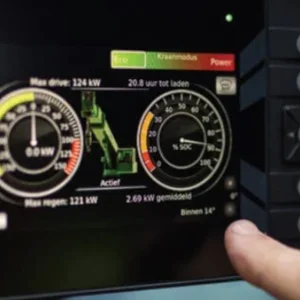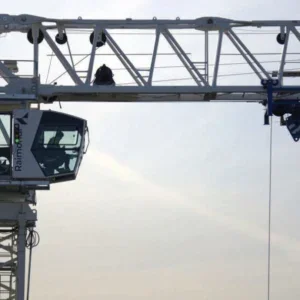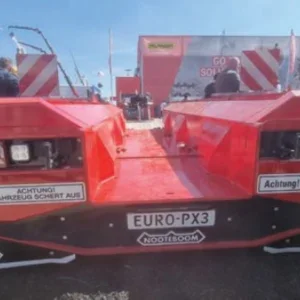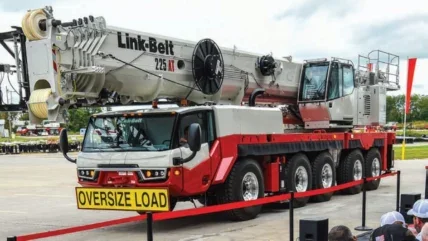
When it comes to lifting it’s often the biggest, tallest cranes that steal the spotlight. But behind the scenes its rough terrain cranes – compact, powerful and relentlessly reliable – that do the dirty work.
Whether navigating remote oil fields, rugged infrastructure sites, or even hard to reach industrial zones, these machines are the backbone of countless operations, the unsung heroes of lifting.
Although many of the rough terrain cranes we will look at in this feature were showcased ‘in the metal’ at the Bauma 2025 trade fair in Germany we’ll start with a company that wasn’t there: Terex Rough Terrain Cranes.
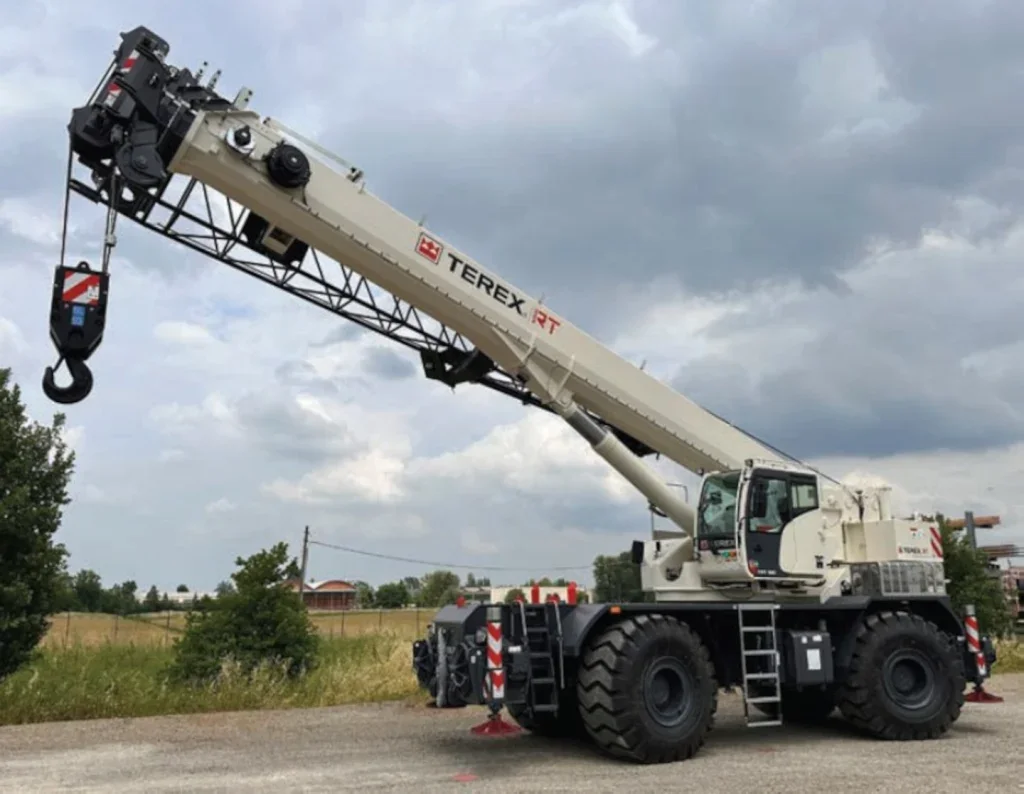
Despite its absence, however, Terex has been very busy of late, developing both its product portfolio and dealership network.
In just the last ten months it’s launched three new rough terrain models: the TRT100, the TRT60, and the TRT50. According to Terex these cranes have been very wellreceived in the marketplace.
The TRT 100 has a maximum capacity of 100 tonnes and main boom length of 47 metres, with a 17m jib stowed on the crane’s side that can be easily attached to the main boom to extend reach. A self-removable counterweight aids operational efficiency, stability, and transportability.
The TRT 60 has a maximum capacity of 60t and main boom length of 42.5m, with a stowable jib of 8-15m.
And the TRT 50 has a maximum lifting capacity of 50t, a maximum main boom length of 37.4m, a maximum tip height of 47.8m, and a maximum hook height of 37.5m.
These cranes are the first to feature Terex’s new ‘IdeaLift’ which aims to optimise load lifting with asymmetric outriggers. Whether fully extended or partially retracted the crane automatically selects the best lifting capacity based on the specific formation of the outriggers.
They all have Terex’s TEOS operating system, compact designs, four steering modes, a proportional full power telescoping boom, an Eco Mode function, and Terex’s T-Link telematics platform. They also come complete with LED lights, a spacious tiltable cabin with large glass surfaces and high-quality components throughout.
Terex has also been busy expanding its rough terrain dealership and service network.
In 2024 it appointed dealers in Saudia Arabia, Turkey, Kazakhstan, and Angola.
This year it has appointed a dealership in Indonesia. “Dealership expansion is an important piece of our five-year strategy,” says Giancarlo Montanari, general manager, Terex Rough Terrain Cranes. “We are monitoring the market closely and decide based on market statistics and local market and dealer potential.”
MARKET ASSESMENT
With regards to the state of demand for rough terrain cranes Montanari is positive. “We are seeing great demand in many regions – particularly in Europe and Africa,” he says. “Demand is mainly driven by the RT concept itself; it’s a very versatile crane. It’s simple to operate and can efficiently be used for many different applications – no matter the ground type and overall challenging environment.
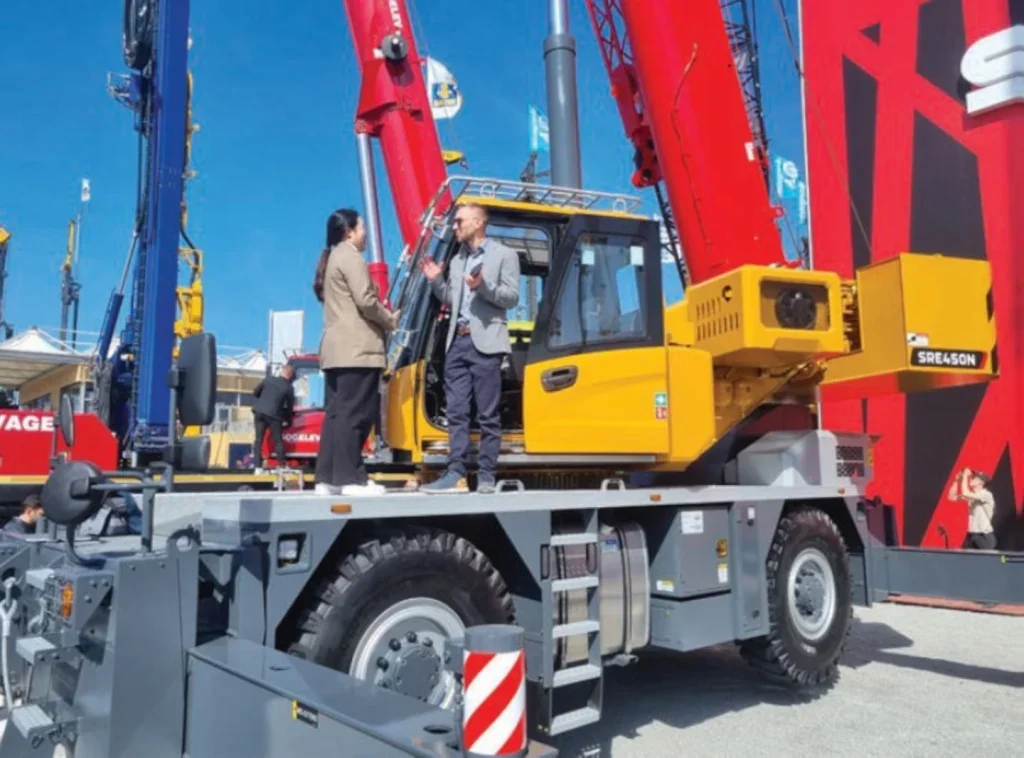
“The Middle East and North America are important areas for us and infrastructure projects there are expecting to grow.”
BUOYANT MARKET
Another crane manufacturer that is upbeat about the state of the rough terrain crane market in 2025 is Kentucky, USA-headquartered Link-Belt Cranes.
“So far this year, the rough terrain market is doing well,” says Kelly Fiechter, product manager of rough terrain cranes at Link-Belt. “Rental fleet utilisation is healthy and our customers tell us their backlog of construction work is good for the foreseeable future.”
Link-Belt was present at Bauma showcasing its 100|RT on the stand. The latest rough terrain addition to its portfolio, however, is actually the 65 ton (60 tonne) 65|RT. The 65|RT launched at Link-Belt’s CraneFest 2024 event and it takes over from Link-Belt’s ultrareliable and long-established RTC-8065 Series II.
“Our 65-ton rough terrain crane has always been a competitive model in the market, as it is easy to transport, extremely operator friendly, and it prioritises comfort regarding its standard operator equipment,” says Fiechter. “The new 65|RT builds on this foundation with new axles, a new transmission, an updated boom telescope system, an LED lighting package, and a new textured paint finish, offering improved footing on walk surfaces.”
Market response to the new model has been good. “We’ve had a 65-ton rough terrain crane in our product line for a long time now,” continues Fiechter. “To our fleet customers and their customers, this crane has been a staple. In turn, response to the new 65|RT has been very good, as expected.”
The 65|RT has a foursection full-power greaseless main boom (38–115 ft [11.6–35m]) and an optional 35–58-ft (10.7–17.7m) offsetable bi-fold lattice fly that are manufactured in the United States at Link-Belt’s headquarters in Lexington, Kentucky.
“Overall, the 65|RT offers a new level of reliability and performance with the same level of precise control and capacity for which our customers have become accustomed,” says Fiechter. “The changes are a reflection of current industry standards with many of these new features also found on other rough terrain cranes in our product line.”
The 65|RT is the smallest rough terrain crane in Link-Belt’s lineup. “I think our customers appreciate its ability to do lots of different types of work while maintaining a small, easy-to-transport package,” Fiechter concludes.
CHINESE CRANES
Moving down to the 45t capacity class, Chinese company Sany showcased its SRE450N rough terrain crane at Bauma.
Sany says the crane is ideal for large-scale construction sites due to its manoeuvrability, speed, and pick and carry capabilities.
The compact crane offers a maximum lifting capacity of 45t and a maximum jib length of 37.4m. This increases to 48m with the crane’s jib extension.
The SRE450N is aimed at the European market. With a transport width of less than 2.55m it is optimised for transportation across Europe.
Sany says it has also adapted the cab of this crane to meet the needs of European drivers. The crane comes with a radio remote control as standard.
Another Chinese crane manufacturer at Bauma, XCMG, covered a range of lifting classes with no less than three rough terrains on display from its G Series portfolio: the XCR50_E, the XCR70_E, and the XCR90_E.
The 50-tonne capacity XCR50_E has a five-section, 37.4m long boom, which can reach a length of 45.8m with a jib installed.
It has a one-metre-wide cab which, XCMG says, provides Sedan-class comfort. The crane measures 2.55m wide by 12m long, providing a tight 6.2m turning radius. It has a smart steering and control system, plus a 168kW high-power engine.
A recent video of the crane can be seen here: www.youtube.com/watch?v=XFKAewjJvs0
The 70-tonne capacity XCR70_E has a new energyefficient hydraulic system that XCMG says significantly reduces fuel consumption. It has a turning radius of 6.5m to aid manoeuvring through tight spaces. The boom extends to 45m and the crane’s maximum hoist height is 57.9m. The crane is aimed at the European market.
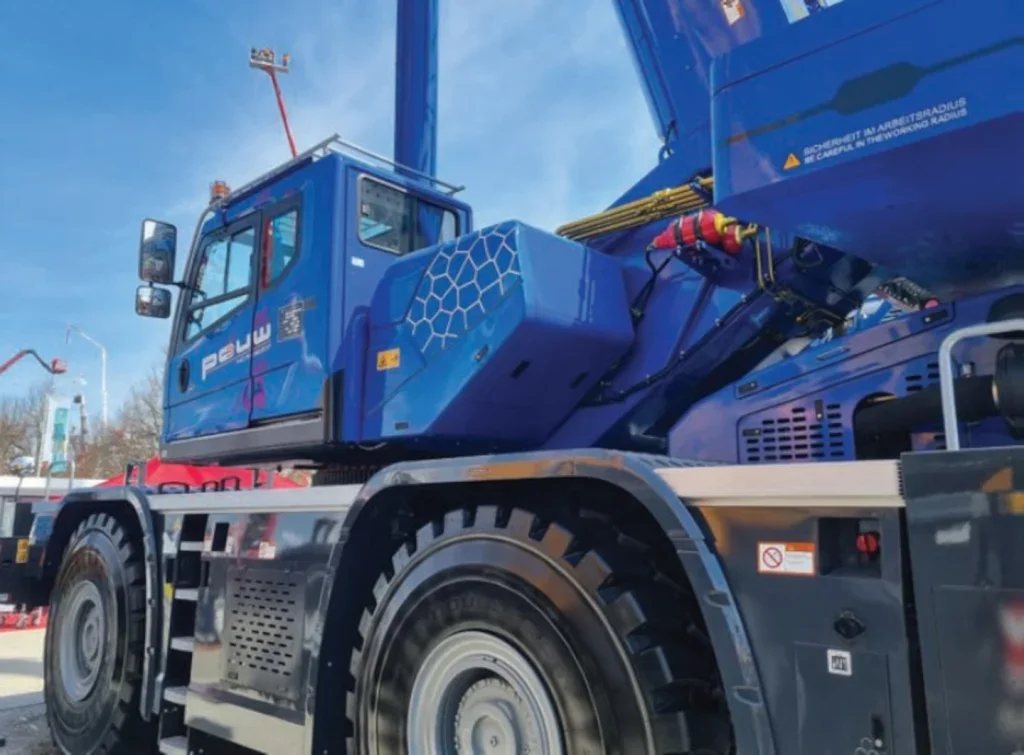
A video of the crane can be seen here: www.youtube.com/watch?v=oGc5tYyXl3o
The 90-tonne capacity XCR90_E has an all-wheel drive system, four steering modes, and forward and reverse driving functions. Its telescopic boom can extend to 48m with a maximum hoist height of 63.1m.
Its minimum turning radius is just 6.5m. Equipped with specialised off-road patterned tyres the XCR90_E can work on operation on all types of construction sites. A video of the crane can be seen here: https://www.youtube.com/watch?v=OmISmxA-NWA
The XCR90_E on XCMG’s stand at Bauma had been sold to Dutch company the Theo Pouw Groep – a one-stop-shop with products and services for the building industry.
At Bauma China (end of 2024) XCMG also launched the 120-tonne capacity XCR120_AU (for the Australian market).
Engineered for rough and rugged terrains, XCMG says this crane is aimed at the mining sector. It is equipped with a highpower HVAC and fresh air system, variable support outriggers, an anti-slip differential lock, plus intelligent steering technology.
A video of the crane can be seen here: www.youtube.com/watch?v=YQEclikWWBk
GREENER FUTURE
Japanese manufacturer Tadano showed its electric eGR-1000XLL-1 at Bauma 2025.
This was the European premiere of this crane, a prototype of which was first shown at Con-Expo 2023.
The electric rough terrain crane is available in North America and Tadano suggests it will soon be available to customers in Europe and Pacific countries soon, too.
“We are currently fleshing out our plans to introduce these emission-free cranes in Europe and Oceania,” says Tadano boss Toshiaki Ujiie. “This is an important part of our de-carbonisation strategy.”
Tadano is looking to reduce carbon emissions from its business activities worldwide by 25 percent and from its products by 35 percent by 2030. In the long term, the company wants to achieve net zero emissions by 2050.
The 90 tonne (100 ton) class eGR-1000XLL-1 has the same the same lifting power as the diesel GR-1000XLL-4 model but with zero emissions and ultra-quiet operation. According to Tadano it provides up to seven hours of lifting or five hours of lifting combined with up to 5.5 miles of onsite travel per charge. It’s ideal for urban construction and other noise- and emission-sensitive environments, says Tadano.
The crane has a 51m boom which can be fully extended in 170 seconds. A smart counterweigh system means that the counterweight can be moved between two mounting positions, increasing lifting capacity by up to 20 percent.
The crane has been designed with ease of transportation in mind and it can be transported at 45.2 tonnes (50 tons) with the counterweight, jib and block removed. The crane also has a Lift Visualiser system designed for enhanced load monitoring which utilises a suspended load monitoring camera.
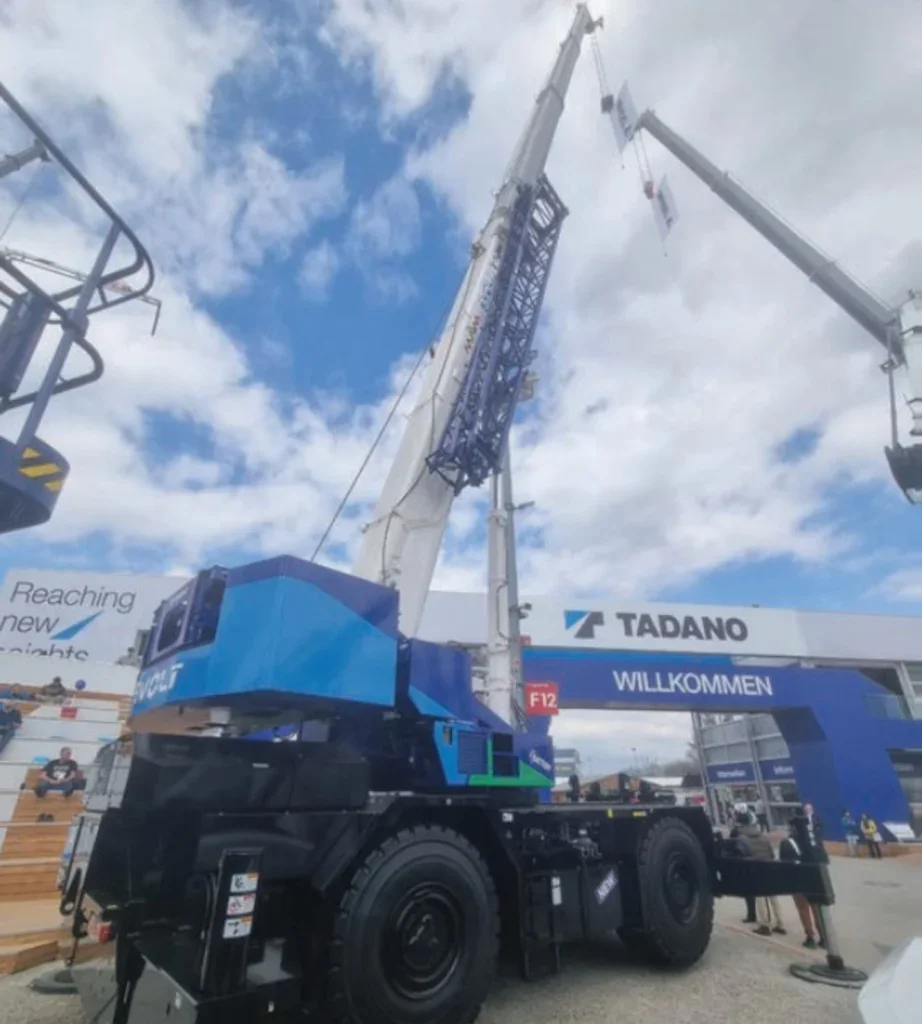
Whilst at Bauma Chilean crane firm Mantención, Proyectos y Montajes (MPM), became the first company in the Pan-American region to buy a model.
The Tadano eGR-1000XLL-1 was sold to MPM by Trex, a leading distributor of lifting equipment in the region.
“We are thrilled to be the first company in the Pan-American region to introduce the Tadano eGR-1000XLL-1 into our fleet,” said Daniel Vega, CEO at MPM. “This investment is not just about expanding our capabilities – it’s about leading the industry towards a greener, more sustainable future. The eGR-1000XLL-1’s performance, combined with its environmental benefits, made it the perfect choice for us.”
A video of MPM’s new Tadano eGR-1000XLL-1 on the stand at Bauma 2025 can be seen here: https://www.youtube.com/watch?v=_+UPAGiboGF&t=40s
MEGA ORDER
Tadano has also been enjoying success with its 80 tonne class GR-800EX rough terrain crane.
At the start of the year Saudibased Arabian Machinery & Heavy Equipment Company (AMHEC) placed an order for 100 GR-800EX units. This is one of the largest orders Tadano has received its 105-year history. According to Tadano, many of the new rough terrains will be used at drilling rigs across Saudi Arabia.
AMHEC was formed in 2007. It is based in Khobar and provides crane rentals, heavy lifting, transportation, and rig move services across the kingdom.
Its crane fleet exceeds 400, many of which are Tadano models.
NEW ERA
US manufacturer Manitowoc showed its latest rough terrain, the 55 ton capacity GRT550, at Bauma. The company describes the crane, which is being manufactured at the Grove factory in Niella Tanaro, Italy, as ‘marking a new era of high-performing rough-terrain cranes.
The GRT550 succeeds the Grove RT550E. It has a fivesection boom with Twin-Lock and Mega-Form and a 39m reach.
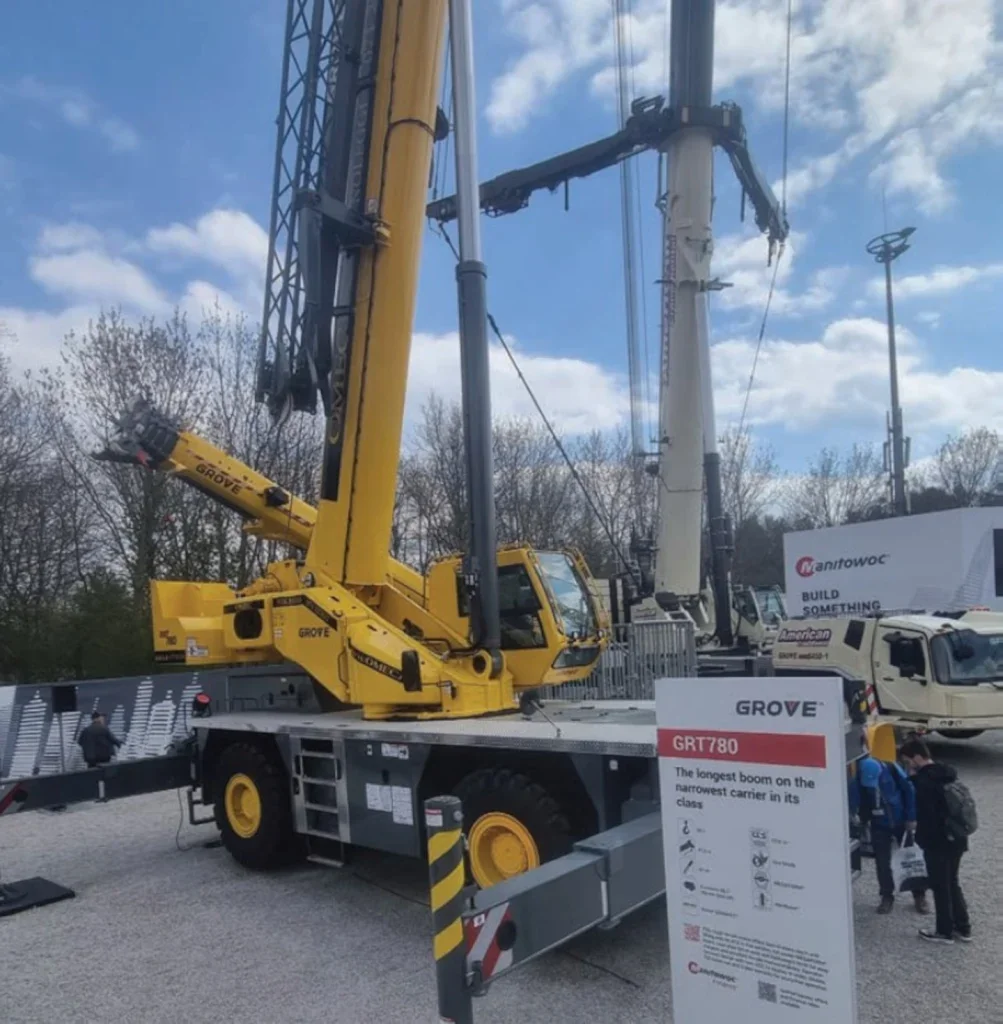
A tip height of 49m is possible with the 8m offsettable swingaway extension. Maximum capacity is 50t and there are overall load chart improvements over the RT550.
The GRT550 also offers a line pull of up to 5,552kg – an increase from the 5,100kg offered by the RT550E. In addition, it requires less line, speeding up rigging time. A a maximum line speed of 155m/ min is possible.
The new crane has a GVW below two tonnes allowing for road transport across Europe without permitting. It is also compact (6.9m long by 2.55m wide).
It has Site Steering mode, to aid handling, plus an updated outrigger system which facilitates smart monitoring of the singlestage outrigger beams. It also offers Grove’s MAXbase variableposition outrigger system.
The GRT550 has a new cab with high-capacity HVAC. Visibility has been improved, says Manitowoc, particularly to the boom and a three-camera system is available as an option. The cab includes an adjustable heated seat with armrest-mounted joystick controls and a new 12-inch CCS 1+ touchscreen display.
Power comes from a proven and reliable Cummins QSB6.7 engine which has an ECO mode for even higher fuel efficiency.
“Retaining features such as remote-mounted filters and centrally located service points shows just how technician-friendly the GRT550 is,” said Daniele Montanaro, product manager for rough-terrain cranes at Manitowoc. “And we’ve added advanced service and diagnostics features such as the Grove Connect fleet management system and our On Crane Service Interface (oCSI). All are designed to make the technician’s job much easier, while uptime reaches new highs – exactly what owners are seeking in a powerful RT crane that’s capable of tackling all general handling and maintenance jobs.”
The crane on Manitowoc’s stand had been bought by Polish crane rental company Petrolift.
Next to the GRT550 at Bauma was another of Manitowoc’s latest Grove RTs: the 80 ton Grove GRT780 – which made its European and trade show debuts at the event. The one on display had been bought by Italian crane rental firm OMEC.
The crane will replace Grove’s RT770E and GRT880. The new model is currently built in Shady Grove, Pennsylvania, although it will also soon be manufactured in Niella Tanaro, Italy, to better serve European and emerging markets.
The crane has a five-section Megaform full-power boom spanning 11.9–47.3m. At full extension, it can handle loads of up to 8.16t at working radii from 9–16 m, while a bi-fold swingaway jib extends reach to 67m. It can achieve a maximum capacity of 715kg when working at its maximum radius of 46m. For pick-and-carry operations 15.2t can be handled at 3.5m with the boom fully retracted.
It has Grove’s MAXbase variable outrigger system, a 12-inch CCS 1+ touchscreen display, a wider full-vision tilting cab, and a new carrier design. Like the GRT765 it has Grove Connect telematics and fleet management and oCSI.
The standard 7,938kg of counterweight can be supplemented with an optional 1,360kg for greater strength; either configuration is compatible with the optional hydraulic counterweight removal system for fast and easy self-assembly.
“The GRT780 is a great demonstration of the productivity, advantages customers get with the latest generation of Grove rough-terrain cranes,” says Daniele Montanaro, product manager for rough-terrain cranes at Manitowoc. “We are looking forward to producing this model in our Niella Tanaro factory. It’s a great option for customers in both European and emerging markets equipped with the latest Cummins Stage V engine to support its impressive strength improvements while delivering cleaner, more efficient operation.”
HIGH END
At the top end of the lifting capacities on display at Bauma was the 130 tonne class LRT1130-2.1 from manufacturer Liebherr.
The crane is Liebherr’s most recent rough terrain model since its re-entry to the rough terrain market. It was first seen as a prototype at Bauma 2022 and was also our cover star on the March 2023 issue (when it was officially launched).
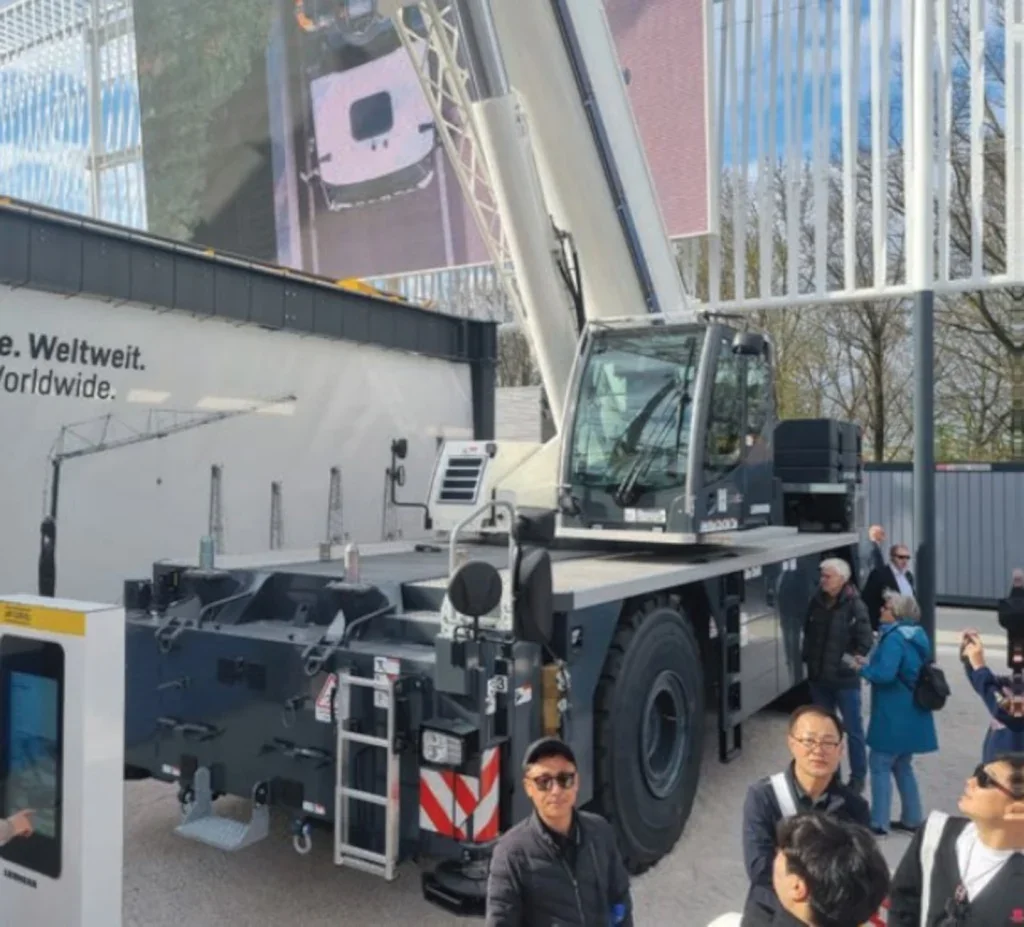
The LRT1130-2.1 has a maximum load capacity of 130 tonnes, a 60m telescopic boom, a maximum hoist height of 85m, and a 66m maximum radius.
At the start of this year Liebher sold one LRT 1100-2.1 and LRT 1130-2.1 to South African company T3 Projects.
To complement the RTs it also bought an LTM 1300-6.3 mobile (all terrain) crane.
The LRT 1100-2.1 has a maximum load capacity of 100t, a 50m telescopic boom, a maximum hoist height of 69m, and a maximum radius of 54m.
T3 Projects specialises in mining and infrastructure projects and handles all the processes from planning, the entire erection process and commissioning. It employs over 900 people in South Africa, Mozambique, DR Congo, Ghana and Burkina Faso.
“As we often work in harsh conditions, we rely on high-quality, robust and powerful equipment,” says Donovan Carroll, operations director at T3 Projects. “LRT rough terrain cranes are known for their advanced safety systems, which helps us to achieve our goal of maximising safety on all projects. At the same time, their simple operation ensures additional safety and increases efficiency.
“The cranes are easy to transport and set up, which saves a considerable amount of time and resources on sites. This will improve our overall project and cost efficiency. We are delighted that we will be able to handle a wider range of projects with the new cranes.”
As the global construction landscape evolves rough terrain cranes remain an important resource in the construction lifting toolkit. They may not grab the headlines like some other crane types but they remain dependable workhorses of jobsites worldwide.
Their off-road agility, compact size, and pick and carry capabilities make them indispensable across oil fields, infrastructure projects and rugged environments. At Bauma and beyond their evolution is quietly but clearly on display. They may not always get the spotlight… but in the world of lifting they are the unsung heroes.


